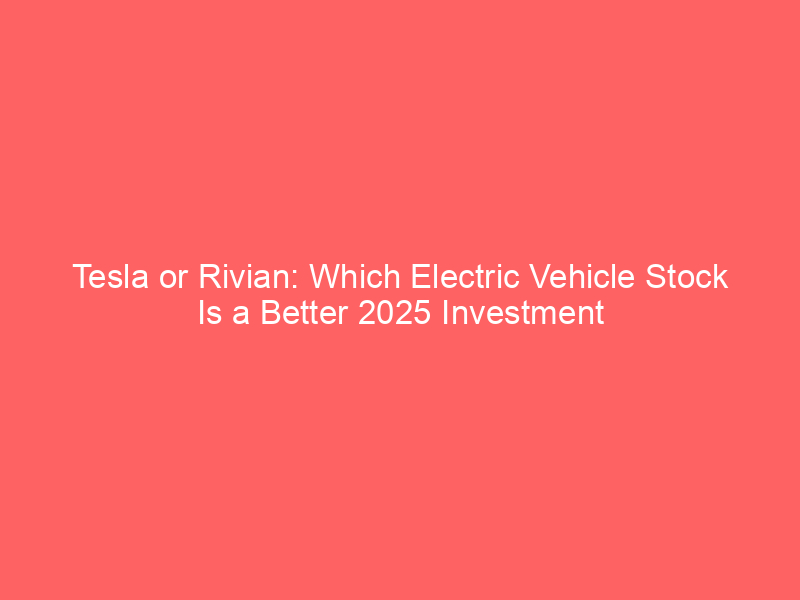As the electric vehicle (EV) market continues to accelerate, investors are carefully evaluating which companies are poised for substantial growth. Tesla, the industry pioneer, remains a dominant force, while Rivian, the newer player with innovative technology and fresh momentum, has garnered significant attention. Both companies have distinct strengths and challenges that could influence their performance by 2025. In this article, we’ll explore and compare Tesla and Rivian to determine which EV stock might be a better investment opportunity in the coming years.
Comparing Tesla and Rivian: Which EV Stock Holds More Growth Potential for 2025
Tesla’s position as the market leader is hard to overlook. With a vast global footprint, a loyal customer base, and diversified product offerings—from cars to energy solutions—Tesla has established itself as a dominant force in the EV arena. The company’s consistent innovation, expanding manufacturing capacity, and advancements in battery technology suggest sustained growth potential. However, its high valuation and increasing competition from traditional automakers entering the EV space pose ongoing challenges. As the market matures, Tesla must continue to innovate and scale efficiently to maintain its growth trajectory toward 2025.
Rivian, on the other hand, is a relatively new entrant that has quickly gained attention with its focus on electric trucks and SUVs designed for adventure and utility. Backed by major investors like Amazon and Ford, Rivian’s unique positioning in the electric pickup and SUV segments could allow it to carve out a lucrative niche. Its recent production ramp-up and strategic partnerships suggest strong growth prospects, especially in the North American market. That said, Rivian faces hurdles such as scaling manufacturing, establishing brand recognition, and navigating supply chain issues. The company’s ability to execute on its ambitious plans by 2025 will be critical in determining its long-term growth potential.
In determining which stock holds more promise for 2025, investors need to weigh Tesla’s proven track record and market dominance against Rivian’s innovative approach and growth potential. Tesla’s established presence might offer more stability, but Rivian’s fresh momentum and niche focus could lead to outsized gains if it successfully scales and captures market share. Both companies present compelling cases, but the decision depends on an investor’s risk appetite and belief in each company’s long-term strategy.
Analyzing Investment Opportunities: Tesla or Rivian for Your 2025 Portfolio
Investing in Tesla in 2025 could be seen as betting on a proven leader that continues to push technological boundaries. Tesla’s extensive infrastructure, such as its Supercharger network, provides a competitive advantage over newer entrants. Its diversified revenue streams, including energy storage and solar solutions, offer additional stability. Moreover, Tesla’s consistent delivery of vehicle deliveries and technological advancements suggest it could sustain growth even as the EV market becomes more crowded. However, the high valuation and market expectations mean that investors need to consider whether Tesla’s growth can outpace current valuations and if it can adapt to increasing competition.
Rivian presents a different kind of opportunity, with a focus on high-growth segments like electric trucks and SUVs. Its recent public listing and support from major investors have provided the capital and credibility needed for expansion. If Rivian can successfully execute its production targets, expand its product lineup, and grow its brand recognition, it could become a significant player in the EV market by 2025. However, investing in Rivian involves higher risk, given its shorter track record and the challenges associated with scaling manufacturing and supply chains. For risk-tolerant investors, Rivian offers the potential for substantial returns if the company can realize its growth ambitions.
Ultimately, a balanced portfolio might benefit from exposure to both Tesla and Rivian, leveraging Tesla’s stability and Rivian’s growth potential. Deciding which stock to prioritize depends on your investment horizon, risk tolerance, and confidence in each company’s strategic vision. While Tesla remains a relatively safer bet given its market dominance, Rivian’s innovative approach presents a compelling opportunity for those willing to accept higher risk for higher potential rewards. As 2025 approaches, monitoring each company’s progress will be key to making informed investment decisions.
Both Tesla and Rivian are shaping the future of mobility, each with unique strengths and challenges. Tesla’s established leadership and diversified innovation provide a solid foundation, while Rivian’s fresh approach and niche focus could unlock substantial growth if executed successfully. For investors aiming for 2025, the choice hinges on balancing risk and potential reward—whether to bet on Tesla’s proven track record or Rivian’s promising innovations. As the EV landscape continues to evolve, staying informed about each company’s progress will be crucial for making smart, future-proof investment decisions.







